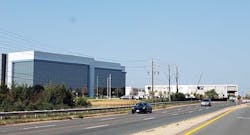To assess trends in the Northern Virginia data center market, Data Center Frontier gathered commentary from six industry CEOs, leasing executives, industry conference panels, and research data from multiple firms. Here’s what we’re hearing.
What does the “new normal” look like for Northern Virginia? After years of rocket-ship growth, the world’s largest data center market is still flying high, but in a slightly lower orbit than in 2018.
For the first time in years, data center developers aren’t racing to keep pace with customers’ insatiable appetite for cloud computing capacity. As hyperscale operators seek to digest their 2018 leasing, landlords are assessing strategies for processing more rational levels of demand – at least for the moment.
There’s no question that activity has slowed in Northern Virginia. In the first half of 2019, data center leasing in the region was about half the total seen in the first six months of 2018.
But last year was an outlier, with demand doubling from the record levels of the previous year. It’s no surprise that the extraordinary leasing during 2018 proved to be unsustainable, as Data Center Alley has been the focus of frenzied development and competition.
At approximately 86 megawatts, the first-half absorption for 2019 is more than has ever been seen in any data center market on earth – except Northern Virginia in 2018. Vacancy rates remain among the lowest in the industry, at about 3 to 4 percent. Analysts say there are signs leasing will pick up in the second half of the year.
Industry executives remain bullish on the region over the long term, but say the slowdown, even if it is short-lived, is changing market dynamics. These impacts include:
- A shift in the balance of data center supply and demand, with less pre-leasing of data center space. In recent years, about 50 percent of new inventory in Northern Virginia has been pre-leased
- The possibility of pricing pressure, as providers may offer discounts to attract tenants. This could be good for customers, who typically have multiple options in competitive markets like Northern Virginia.
- Timing is more important. Some new construction projects are being re-evaluated or delayed, as developers conserve capital for the next burst of hyperscale demand.
“The supply/demand pendulum has swung away from providers in favor of customers, with various new entrants bringing speculative supply online, while the most voracious consumers remain in digestion mode.” said William Stein, CEO of Digital Realty, the largest landlord in Northern Virginia. “Ultimately, we believe it’s a question of when, not if hyperscale procurement cycles enter their next phase of growth, and the pendulum can swing back the other direction quickly.”
“I think that the Northern Virginia market is absolutely overbuilt,” said Gary Wojtaszek, CEO of CyrusOne. “There was like a gold rush mentality going on there with land acquired to probably last 10 years worth of inventory.”
The Demand Outlook
As cloud providers compete for clients and capacity, data centers will be the front line. As a result, the leading cloud computing players are working to amass capacity for the clouds of the future, which is ramping up demand in Northern Virginia and led to giant deals for data center space in 2018. Site selection strategist Allen Tucker estimates that there was a record 270 megawatts (MWs) of leasing in Northern Virginia leased during 2018, including a single 72-megawatt deal.
Tucker says there has been 86 MWs of leasing in Northern Virginia during the first half of 2019, compared to 173 MWs at mid-year 2018. A Newmark Knight Frank report using data from datacenterHawk found 62 MWs of leasing in the region in the first half of 2019.
“Keep in mind that no other data center market in the world has ever exceeded 70 MWs of annual absorption,” Tucker wrote in a market update on LinkedIn. “I believe this reduction represents a momentary pause as demand takes a breath after an enormous 2018. … Very simply, markets are adapting, and transitioning after years of rapid growth and record demand.”
A multi-year chart of absorption in Northern Virginia, via Allen Tucker.
A mid-year report from CBRE reported 126 megawatts of leasing in Northern Virginia for the first half of 2019, a significantly larger number than Tucker or datacenterHawk. The disparity is due to differences in methodologies, as CBRE counts absorption when new supply is delivered, rather than when the lease is signed. As a result, leases signed in late 2018 factor into the 2019 first-half data for CBRE.
“I think there’s been a slight decrease in hyperscale leasing (in Northern Virginia in 2019),” said Jamie Jelenik from CBRE’s Data Center Solutions Group. “You have to remember that there was a 70-megawatt lease. That was an anomaly, and really skews things.
“We’ve seen a baseline of 40 to 60 megawatts of non-hyperscale demand every year for the last three years in Northern Virginia,” said Jelenik. “We really look at that baseline, and we expect it will be steady this year as well. There will still be hyperscale deals this year, but the sentiment seems to be that this activity will pick up in early 2020.”
Compass Datacenters CEO Chris Crosby says the region is experiencing a temporary hangover from the blockbuster 2018 leasing numbers. “I think there were some sizable deals that inflated the numbers that were really more ‘forward reservation’ deals,” said Crosby.
Meanwhile, a report from Synergy Research Group attributed the first-half slowdown to a drop in activity by Chinese hyperscale companies.
“Usually it is the big five (Google, Amazon, Facebook, Microsoft and Apple) that dictate the scale and trends in hyperscale capex, but the drop-off in spending in China has been so marked that an otherwise strong worldwide growth story has been transformed into a modest capex decline,” said John Dinsdale, a Chief Analyst at Synergy Research Group. “After some short-term financial belt-tightening, we expect to see Chinese capex rise strongly once again.”
The Supply Outlook
The biggest challenge facing the Northern Virginia market is that there’s ample supply in the pipeline. DatacenterHawk estimates that there’s 1.07 gigawatts of commissioned data center power in the Northern Virginia market, with another 2.6 gigawatts of planned capacity. New projects include:
- Vantage Data Centers entered the market earlier this year with the first building on its new Ashburn campus.
- Aligned Energy recently launched a large new data center in Ashburn, making its entry into Northern Virginia.
- CoreSite is opening a new facility this week in Reston, Virginia, allowing the company to market larger footprints after approaching capacity in its existing buildings in Reston.
- In coming months Sabey Data Centers is expected to open a new data center in Ashburn.
- Meanwhile, QTS has space available in its QTS Ashburn site, which opened last year.
- STACK Infrastructure also has capacity available in its Ashburn location, the former AOL data center.
The QTS Data Centers facility in Ashburn, Virginia. (Photo: Rich Miller)
Other announced projects appear to be biding their time. Three private companies that bought land for data center projects in 2017 and 2018 – Cologix, EdgeCore and Chirisa TechCenters – have yet to begin significant construction.
“We’re seeing that some of the buildings that we expected to come out of the ground by now appear to have been postponed,” CoreSite CEO Paul Szurek said on the company’s mid-year earnings call. “We are aware of a couple of prospective builders who have publicly said they’re going to go on pause and just look for build-to-suit opportunities.”
“Some of the private outfits who have entered the market in the last 12 to 18 months may not move forward with speculative capacity,” Stein said on the Digital Realty earnings call.
CyrusOne had a busy first half of 2019, delivering 36 megawatts of capacity at its Sterling V and Sterling VI buildings. But the company is slowing its development timetable on future projects in Northern Virginia, according to CEO Wojtaszek.
“We build product in line with the demand that we are tracking,” Wojtasek said in the company’s second quarter earnings call. “So if we see demand slowing down, then we will be pushing out our capital spend. In Q4 of 2018 I was noticing a significant pullback in leasing velocity, particularly in the hyperscalers, and quickly adjusted our business plan accordingly.”
‘There’s Always Talk About Pricing’
Concerns about oversupply inevitably lead to a focus on pricing, especially in a highly-competitive market like Northern Virginia.
“We’ve been saying for about two years now that pricing for hyperscale is coming down in Northern Virginia,” said Szurek on CoreSite’s earnings call. “I would say that over the last three to six months has continued to deteriorate a bit. It may be bottoming out right now.”
While some discounting may be situational, the trend toward competitive pricing is also tied to structural improvements in the cost of data center financing and construction. Access to cheaper capital has been a historic strength for market leader Digital Realty, which has lower borrowing costs due to its investment grade credit rating. Streamlined construction has been a differentiator for CyrusOne. These improvements have allowed these companies to maintain profit margins in competitive price environments.
Aligned Energy CEO Andrew Schaap says that a new class of investors in the data center sector is accelerating this industrialization trend. That includes Macquarie, the infrastructure fund that is Aligned’s leading investor. At the recent opening of Aligned Ashburn, Schaap said that Aligned was benefiting from a low cost of capital and supply chain efficiencies, allowing it to compete while still maintaining healthy margins.
The massive CyrusOne Sterling V and VI data center complex, which added 36 MWs of occupied tenant space this year. (Photo: Rich Miller)
Equinix, the largest colocation specialist in the region and a focal point of development in Ashburn, recently earned investment grade status, which will help its capital costs on new builds.
CyrusOne cites its ability to deploy data center capacity at a cost of about $6.5 million per MW as a competitive edge. “Our yields in the (Northern Virginia) market for the hyperscalers haven’t really changed,” said Wojtaszek. “We’re still expecting in the low-double digits on a yield basis.
“There’s always a tremendous amount of talk about pricing,” he added. “I don’t know where prices will shake out. But most of the ‘supply’ that we’re looking at is land.”
Northern Virginia “is a market where there are certain private operators that are solely competing on price,” said Stein of Digital Realty. “That will likely result in deals just to fill capacity, and my guess is it will be short-lived, given the competition.
“We’re picking our spots,” Stein said.”We’re trying to find customers that really value our product offering and not just going to the lowest common denominator on price. We’ve been winning on those merits for some time.”
Competition: Public vs. Private, or Global Reach?
Securities analysts have questioned whether privately-held developers will impact the competitive landscape in Northern Virginia. Executives at public data center REITs express confidence that the newcomers won’t shift the balance of power.
“Historically, 90 percent of all the deals that have happened in Northern Virginia have gone to the public players, with the exception of a couple of deals that were awarded when everyone else ran out of capacity,” said Wojtaszek. “World-class organizations tend to deal with public companies with strong balance sheets.”
Douglas Adams, the President and CEO of RagingWire/NTT Data Centers, notes that his company has had “incredible success” in Northern Virginia. Adams says the choice isn’t one of public versus private, but a question of scale and reach.
“I think the playing field is becoming less level, and tilting toward the large global providers,” said Adams. “I think the whole complexion of the market is changing. The cloud providers are quickly choosing who they can work with. Most of the large players are choosing two or three providers as partners.”
“I think the playing field is becoming less level, and tilting toward the large global providers.”
Douglas Adams, RagingWire/NTT
One of the new private players in Northern Virginia is Compass Datacenters, which is already working with hyperscale customers in other markets, and building a campus near Leesburg. Compass CEO Crosby says the region is experiencing a temporary hangover from the blockbuster 2018 leasing numbers.
“I think there were some sizable deals that inflated the numbers that were really more ‘forward reservation’ deals,” said Crosby.
Crosby said that a developer’s time horizon matters, and that’s usually shaped by the company’s business model.
“Northern Virginia is a fantastic market for build-to-own,” said Crosby. “If you’re doing build-to-exit versus build-to-own, you can get caught in cycles. The key question is this: What differentiates you in that market besides price?”
The Road Ahead
Tucker noted one clear trend in the 2019 data: The continued emergence of Manassas in Prince William County, which saw 25 MWs of leasing in the first-half stats.
“This year we started to see real growth in Prince William County,” said Tucker. “Innovation Alley (the data center corridor in Manassas) had greater demand absorption than all collective East Coast Tier 1 data center markets outside of Ashburn. Northern Virginia’s second-largest submarket is now a top location for data center demand in its own right.”
“Northern Virginia is a fantastic market for build-to-own. If you’re doing build-to-exit versus build-to-own, you can get caught in cycles.”
Chris Crosby, Compass Datacenters
There have also been land purchases for data center development in Arcola, South of Ashburn in Loudoun County. Amazon Web Services has deployed four data centers in the area, with more on the way. Google, Digital Realty and CyrusOne have bought up a combined 550 acres of land, laying the groundwork for millions of square feet of future data center development.
But the focal point of the Northern Virginia data center market will likely continue to be Ashburn, and industry executives expressed confidence that any turbulence will be temporary.
“Cloud has slowed down a bit this year, but it will pick up,” said Stuart Dyer, Business Development Manager at CyrusOne. “Cloud is lumpy.”
“I think the future looks a lot like the past, just without the irrational exuberance,” said Lee Kestler, the Chief Commercial Officer of Vantage Data Centers, and a veteran observer of the Northern Virginia market.
Digital Realty CEO William Stein concurred.
“Ashburn is obviously the largest market in the world,” said Stein. “It’s been the most robust and diverse. We think these hyperscalers are going to resume their growth. We think that this market is going to work through this current supply demand/challenge, and we’re optimistic on the market.”






